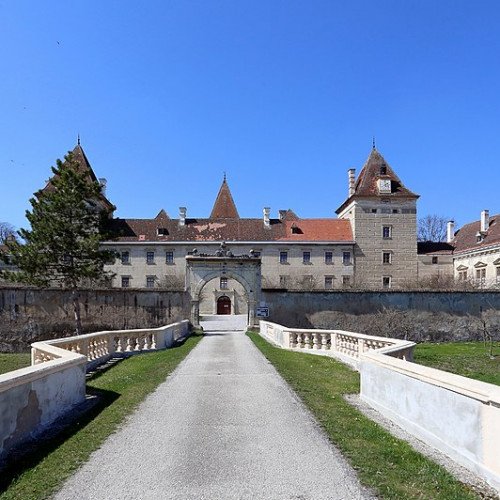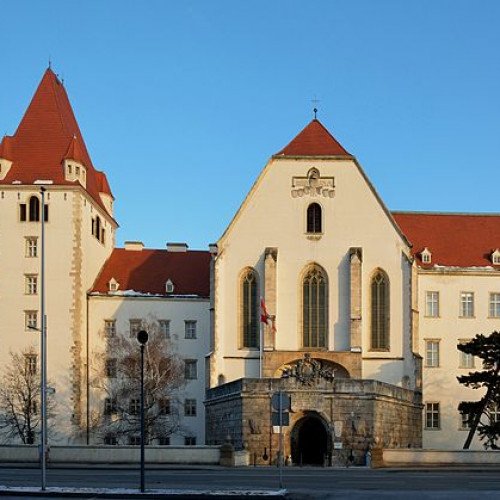Castles of "Austria" SCHLOSS WALPERSDORF vs BURG WIENER NEUSTADT

SCHLOSS WALPERSDORF
Schloss Walpersdorf is a castle in Lower Austria, Austria. Schloss Walpersdorf is 249 metres (817 ft) above sea level.
Statistics for this Xoptio

BURG WIENER NEUSTADT
Burg Wiener Neustadt is a castle in Wiener Neustadt, Lower Austria, Austria. Burg Wiener Neustadt is 268 metres (879 ft) above sea level. The first castle in Wiener Neustadt was built in 1193–94, when at the same time, the city walls of Wiener Neustadt were built. The costs were paid from the ransom of Richard the Lionheart. This castle is said to have stood on the north-eastern corner of the city, but there is no archaeological evidence of this. When that castle became too small, however, the newer castle was built on the present site by Leopold VI the Glorious at the beginning of the 13th century. Since the area is quite marshy, it was built on wooden piles. Under Frederick II the Quarrelsome it was finally surrounded by a moat, outer walls and towers. In 1246 east of the castle the Battle of the Leitha was fought, when Frederick II was killed. A monument at Burgenland road still reminds of it. In 1260 the castle was first mentioned in documents. The wall was removed, however, under Otakar II of Bohemia already in 1253 and built up again in the late 13th Century. During an earthquake in 1348 the castle collapsed. This led to a larger new building under Leopold III starting in 1378. On the terrace that was built over the tomb chapel of Leopold IV Peter Pusika on behalf of Duke Ernest the Iron built the Gottsleichnamkapelle (God's Body Chapel) and later, on behalf of Emperor Frederick III the St George's Chapel in the newly created West Wing. In many places of the castle the inscription “A.E.I.O.U.” can still be found, which dates back to Frederick III. When Frederick III refused to dismiss Ladislaus the Posthumous from his guardianship, this led to creation of the Mailberg Confederation (Mailberger Bund) and a siege of the castle in 1452 by an Estates' army of 16,000. Only after negotiations Frederick dismissed his ward. Subsequently, he founded the St. George's Order and made the castle available as the Order's seat. The seat, however, was repealed in 1598. 1486 saw a renewed siege by Matthias Corvinus, which ended after two years with the defenders' surrender. Only after Matthias' death in 1490 the occupation troops were expelled again from castle and city. Under Emperor Maximilian I, the castle lost the status of permanent residence and it became only a retreat of the emperor. Maximilian was buried in St. George's Chapel, although previously a tomb had been built in the Innsbruck Court Church. In 1521 Ferdinand I retreated to the castle because of the resistance of the Protestant Estates. Subsequently, though, the Vienna city government was arrested, and they were brought to trial (Wiener Neustädter Blutgericht, i.e. Wiener Neustadt Bloody Trial) and executed here. However, also other celebrities were detained in a tower that was adapted as a state prison, the Rákócziturm (Rákóczi Tower), such as Francis II Rákóczi or Peter Count Zrin. During the first Turkish Siege of Vienna in 1529, the castle was attacked but not conquered. During the second siege in 1683 it was not attacked. In the meantime, however, in the years 1608 and 1616 fires caused major damage. In 1743 1,400 French prisoners of war were detained in the castle. A little later, a pestilential epidemic broke out, which claimed many victims. The castle therefore remained closed because of the risk of infection for two years after withdrawal of the survivors. Thereafter, it was hardly used and neglected. In 1751 the Theresian Military Academy was established in the castle by Maria Theresa of Austria. This involved numerous changes which were implemented by Viennese architect Matthias Gerl. In 1768, an earthquake again caused severe damages, which made the building uninhabitable. Three of the four towers had to be removed. In the east wing new rooms were furnished for the emperor. In the place of God's Body Chapel, the main staircase was erected. After World War I, the military academy was closed, but reopened in 1934. During the bombings at the end of World War II in 1944–45, the castle – just like the city as a whole – was so badly damaged that only the outer walls remained standing. It was rebuilt after the war so that the military academy was able to resume operations in 1958. The castle, which had always been the sovereign's property, is now owned by the Republic of Austria.